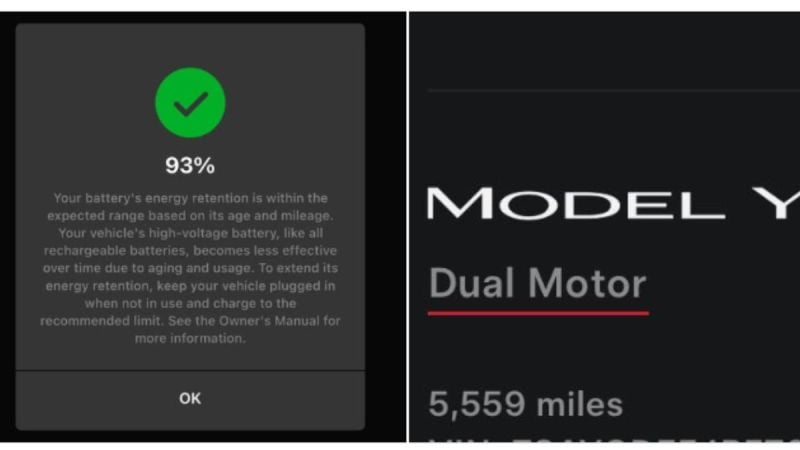Battery anxiety is one of those topics that quietly haunts many EV owners, especially those who are meticulous about their charging habits and still notice an unexpected dip in range. It’s the kind of subtle worry that doesn’t show up on a warning screen, but instead lingers in the back of mind. That’s exactly what happened when I came across a post in the “Tesla Model 3 and Model Y Owners Club” Facebook group this evening. A post by Eddie Khalili caught my eye. He shared that his 2023 Tesla Model Y Performance has just 5,500 miles on it, yet his battery health has already dropped to 93%. He’s never charged it past 80%, never let it drop below 35%, and uses a 240V home charger at 48 amps. Despite this cautious routine, the numbers don’t seem to reflect his effort. With other owners reporting 98% after 35,000 miles, it left him questioning what went wrong, if anything.
Here’s how Eddie put it: “Should I be concerned that my battery health is 93% after only 5,500 miles on a 2023 MYP? I never charge it past 80% and never let it go below 35%, and only charge at home at 48 amp/240v. Granted, I have a heavy foot, but I’m a little worried based on other people having 98% after 35k miles.”

Understanding Battery Health and What It Means
For a lot of Tesla owners, battery health is more than just a number as it’s a reflection of the long-term promise of owning an EV. When numbers start dipping unexpectedly, it can feel like a red flag. But is 93% really cause for concern?
Tesla’s battery management system (BMS) estimates the maximum range the vehicle can deliver based on various factors: usage patterns, charging behavior, software calibration, and even ambient temperatures. So when owners notice that their estimated range or battery percentage has dropped, it doesn’t always mean the battery has physically degraded by that amount.
The Bigger Picture: How Much Should We Worry?
Early battery degradation, and as what many owners call the "initial drop," is actually a known and expected phenomenon. Lithium-ion batteries, including those used in Teslas, tend to show quicker range loss in the first 10,000 to 20,000 miles before the curve flattens out.
That’s exactly what one commenter, Jadher Escobar, echoed in response to Eddie’s post: "Don’t worry and don’t pay too much attention to those numbers. The same thing happened to me, and now the battery is adjusting and the range is improving. Tesla cars experience faster degradation during the first 15,000 to 20,000 miles, but after that, they stabilize and the degradation slows down. Right now, my car has 26,000 miles, and the degradation has stopped. I’ve actually regained some range."
This experience mirrors what many long-time Tesla owners have seen across both Model 3 and Model Y platforms. Degradation isn’t always linear, and the car’s BMS continues to adjust as more data is collected from real-world driving. Software updates can also recalibrate how the car estimates its available range.
While it’s understandable to feel anxious seeing a 7% drop at just 5,500 miles, Jeff Isaac offers a more measured perspective: "Your battery’s energy retention is within the expected range based on its age and mileage. I hope this helps answer your question."
Tesla doesn’t publicly publish exact thresholds for battery health by mileage, but studies and anecdotal data suggest that most owners can expect to lose about 5-10% in the first 25,000 miles, then just 1-2% per year after that. That aligns closely with what Eddie is seeing now, and if anything, his experience may be slightly on the early side, but not out of the ordinary.
On the other hand, some owners have seen more extreme cases. One commenter named Lets Go Brandon said, “I have 83% after 35k miles on my ‘22 MYP.” That kind of drop could be concerning, especially if no aggressive driving, extreme weather, or fast charging has been involved.
Why This Matters Beyond Just Numbers
This isn’t just about Eddie or a single Facebook thread as it taps into a growing curiosity many Tesla owners have around how these batteries perform in the real world. Similar concerns have been echoed by those who were once hesitant but ultimately made the leap, like in this article that I wrote exploring if Tesla ownership is really worth the hype despite what critics say. It’s one thing to hear the tech pitch when buying the car. It’s another to see how well the promises hold up over time.
As owners clock more miles, they often begin to track every fluctuation in range, trying to decode what’s happening behind the scenes. And in many cases, that tracking turns into a form of anxiety, especially when others are reporting better results under seemingly similar conditions.
But context is everything. The climate, daily driving habits, elevation changes, and even tire size all play a part in how a battery behaves and how the BMS interprets it. Some owners, like those featured in the real-world experiences of switching from a Lexus to a Tesla Model 3, discover that EV ownership means adapting to new expectations and learning what really matters in the long run.
What Tesla Says and What Owners Actually See
Like I stated earlier, officially, Tesla doesn't give owners direct access to battery health statistics in the vehicle interface. This lack of transparency is one reason some prospective buyers weigh whether Tesla is still the right choice, as detailed in this piece where Tesla owners discuss if they would buy one again, without politics involved. Instead, apps like Scan My Tesla, Tessie, and Stats for Tesla are used to estimate BMS-calculated capacity. These tools are not always 100% accurate and depend heavily on full battery cycles to give consistent readings.
Tesla’s warranty does cover the Model Y’s battery for 8 years or 120,000 miles (whichever comes first), and it guarantees at least 70% capacity retention during that time. This means that even if your battery drops to 85% or even 80%, it’s technically still within warranty limits.
That said, posts like Eddie’s are still important. They provide a snapshot into the concerns many new EV owners face, especially those who, like Eddie, have gone out of their way to charge responsibly. And it’s not just owners of the Performance model as it’s happening across different trims and model years.
Take, for instance, this owner who gave up a Toyota Tundra for a Tesla Model 3 and finally understood the hype. Stories like these are often filled with surprises, good and bad, as people adapt to the nuances of EV technology.
Reflecting on the Bigger Picture
As someone who closely follows the evolution of EVs, especially Tesla’s rise to the top of the electric market, I’ve noticed a pattern. And while Tesla continues to innovate, there are signs of what may be coming next, like the prototype recently caught testing with camouflaged upgrades hinting at future Model 3 changes.
New owners often feel blindsided by the subtle complexities of battery performance. The marketing tells us one thing, and then the forums tell us another. And reality? It’s usually somewhere in between.
I think it’s easy to obsess over numbers without understanding the bigger picture. Battery health is a dynamic metric and not a fixed measurement. It changes, it recalibrates, and it reflects not just your driving habits but the car’s ever-adapting understanding of your driving style.
Eddie’s post is relatable because it captures that moment of doubt so many of us face as owners like wondering if we’re doing something wrong or if the car just needs time to settle in. The truth is, a 7% drop at 5,500 miles might not be great, but it’s also not catastrophic. The key is to keep tracking, keep learning, and not jump to conclusions based on early data alone.
Key Takeaways for Tesla Owners and Curious Readers
- Initial battery health drops are normal: Expect the first 5-10% of range loss to occur in the early miles, often before 15,000.
- Don’t overanalyze a single number: BMS readings can fluctuate and aren’t always perfectly accurate without full charge/discharge cycles.
- Heavy-footed driving won’t kill your battery alone: Aggressive driving may affect efficiency more than actual degradation.
- Tesla warranties are still generous: Unless you fall below 70% capacity, Tesla considers your battery within spec.
- Community insight can be your best tool: Sharing and comparing with others can help you figure out what’s normal and what’s not.
How's Your Battery Health?
Have you noticed any unexpected battery health changes on your EV?
How closely do you monitor your range and capacity? Has it ever made you question your charging habits and whether something is wrong?
I'd love to hear about your experiences in the comments below.
Aram Krajekian is a young automotive journalist bringing a fresh perspective to his coverage of the evolving automotive landscape. Follow Aram on X and LinkedIn for daily news coverage about cars.
Image Sources: Tesla Gallery and the "Tesla Model 3 and Model Y Owners Club" public Facebook group.











